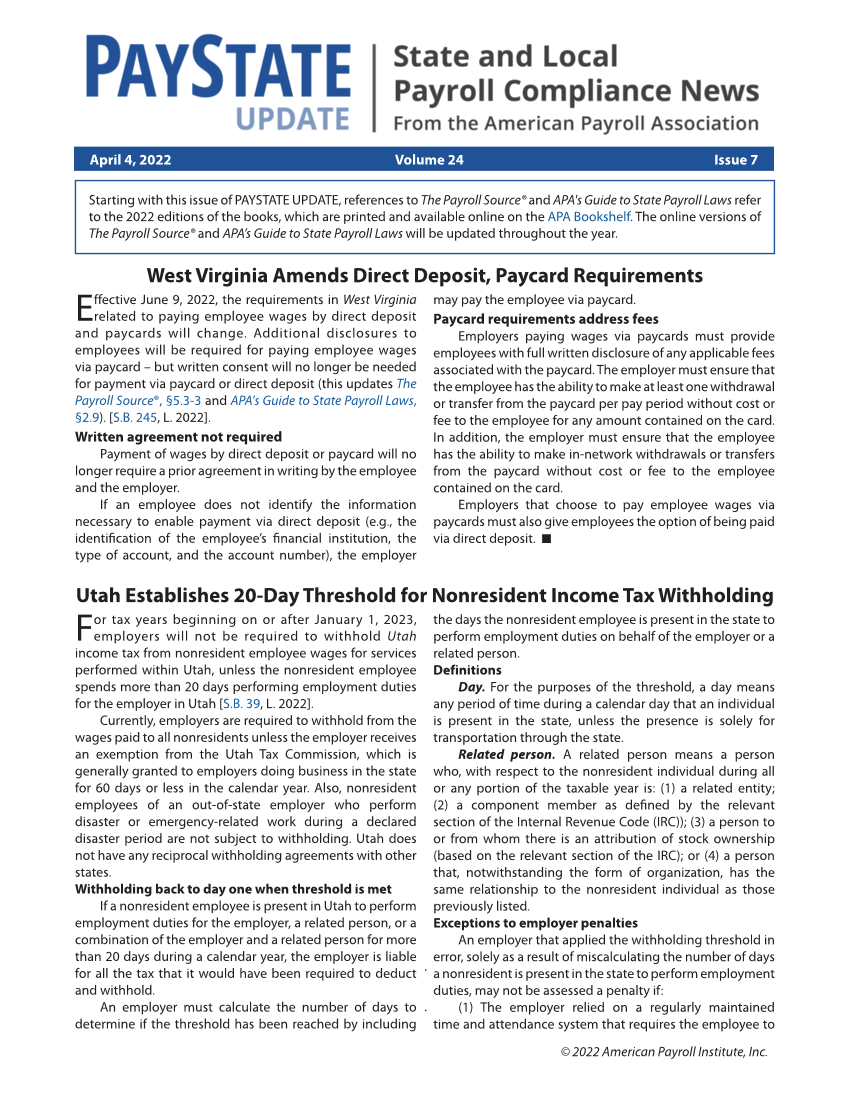© 2022 American Payroll Institute, Inc. West Virginia Amends Direct Deposit, Paycard Requirements Effective June 9, 2022, the requirements in West Virginia related to paying employee wages by direct deposit and paycards will change. Additional disclosures to employees will be required for paying employee wages via paycard – but written consent will no longer be needed for payment via paycard or direct deposit (this updates The Payroll Source®, §5.3-3 and APA's Guide to State Payroll Laws, §2.9). [S.B. 245, L. 2022]. Written agreement not required Payment of wages by direct deposit or paycard will no longer require a prior agreement in writing by the employee and the employer. If an employee does not identify the information necessary to enable payment via direct deposit (e.g., the identification of the employee’s financial institution, the type of account, and the account number), the employer may pay the employee via paycard. Paycard requirements address fees Employers paying wages via paycards must provide employees with full written disclosure of any applicable fees associated with the paycard. The employer must ensure that the employee has the ability to make at least one withdrawal or transfer from the paycard per pay period without cost or fee to the employee for any amount contained on the card. In addition, the employer must ensure that the employee has the ability to make in-network withdrawals or transfers from the paycard without cost or fee to the employee contained on the card. Employers that choose to pay employee wages via paycards must also give employees the option of being paid via direct deposit. Utah Establishes 20-Day Threshold for Nonresident Income Tax Withholding For tax years beginning on or after January 1, 2023, employers will not be required to withhold Utah income tax from nonresident employee wages for services performed within Utah, unless the nonresident employee spends more than 20 days performing employment duties for the employer in Utah [S.B. 39, L. 2022]. Currently, employers are required to withhold from the wages paid to all nonresidents unless the employer receives an exemption from the Utah Tax Commission, which is generally granted to employers doing business in the state for 60 days or less in the calendar year. Also, nonresident employees of an out-of-state employer who perform disaster or emergency-related work during a declared disaster period are not subject to withholding. Utah does not have any reciprocal withholding agreements with other states. Withholding back to day one when threshold is met If a nonresident employee is present in Utah to perform employment duties for the employer, a related person, or a combination of the employer and a related person for more than 20 days during a calendar year, the employer is liable for all the tax that it would have been required to deduct and withhold. An employer must calculate the number of days to determine if the threshold has been reached by including the days the nonresident employee is present in the state to perform employment duties on behalf of the employer or a related person. Definitions Day. For the purposes of the threshold, a day means any period of time during a calendar day that an individual is present in the state, unless the presence is solely for transportation through the state. Related person. A related person means a person who, with respect to the nonresident individual during all or any portion of the taxable year is: (1) a related entity (2) a component member as defined by the relevant section of the Internal Revenue Code (IRC)) (3) a person to or from whom there is an attribution of stock ownership (based on the relevant section of the IRC) or (4) a person that, notwithstanding the form of organization, has the same relationship to the nonresident individual as those previously listed. Exceptions to employer penalties An employer that applied the withholding threshold in error, solely as a result of miscalculating the number of days a nonresident is present in the state to perform employment duties, may not be assessed a penalty if: (1) The employer relied on a regularly maintained time and attendance system that requires the employee to April 4, 2022 Volume 24 Issue 7 Starting with this issue of PAYSTATE UPDATE, references to The Payroll Source® and APA's Guide to State Payroll Laws refer to the 2022 editions of the books, which are printed and available online on the APA Bookshelf. The online versions of The Payroll Source® and APA’s Guide to State Payroll Laws will be updated throughout the year.
Printed for: PayrollOrg Bookshelf © 2024 American Payroll Institute, Inc. All Rights reserved. From: PayrollOrg Digital Publications (bookshelf.payroll.org)






